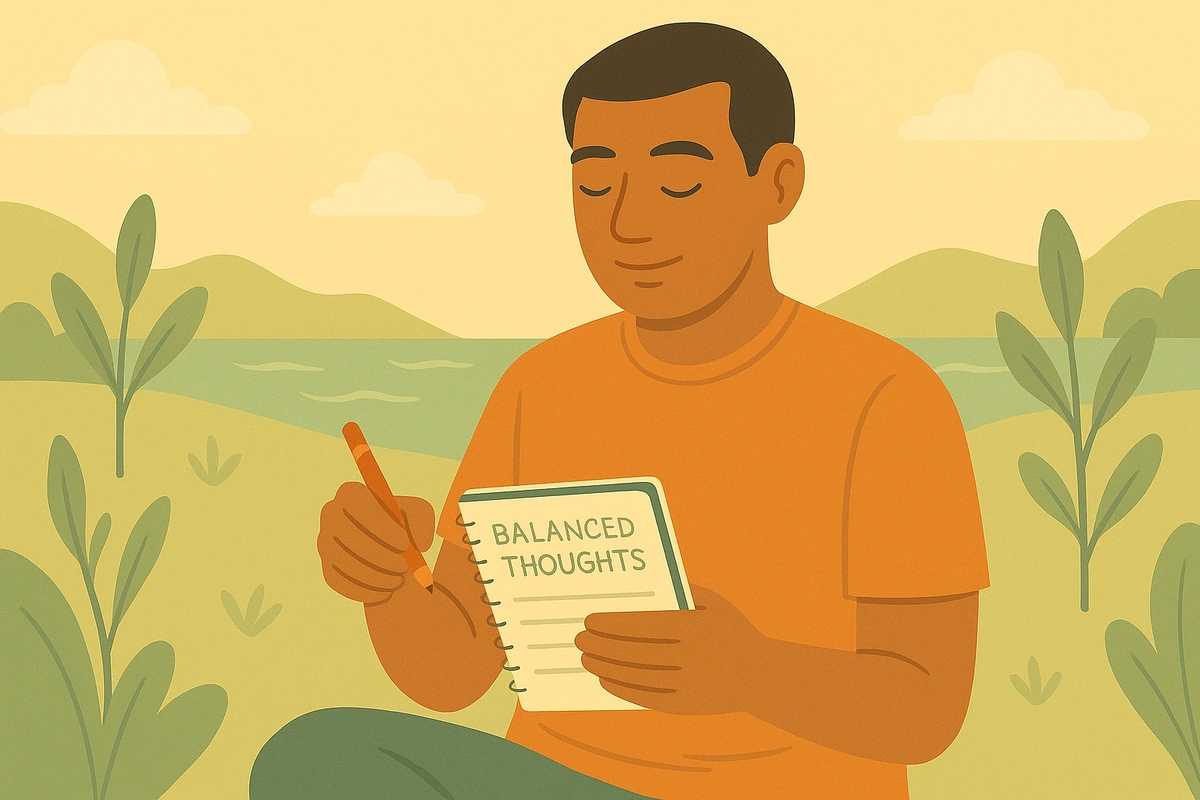Balanced thought writing helps you break free from negative thinking patterns by teaching you to identify and challenge the thoughts that fuel anxiety and depression, replacing them with evidence-based, realistic perspectives that support mental wellness and emotional resilience.

Balanced thought writing is a cognitive-behavioral technique that teaches you to recognize, examine, and replace automatic negative thoughts with more balanced, realistic alternatives. Think of your mind like a courtroom where negative thoughts act as the prosecutor, presenting only one side of the story. Balanced thought writing helps you become both the defense attorney and the judge, ensuring you hear all the evidence before reaching a verdict.
This structured journaling approach helps break the cycle of distorted thinking that contributes to anxiety, depression, and emotional distress. Research shows that CBT techniques like thought challenging can be highly effective for managing various mental health conditions by helping you develop more accurate and helpful thinking patterns. When you consistently practice examining your thoughts objectively, you build new neural pathways that support healthier emotional responses to life's challenges.
Balanced thought writing works by interrupting the automatic connection between triggering events and emotional reactions. When something stressful happens, your brain immediately interprets the situation and generates thoughts about what it means. These interpretations - not the events themselves - largely determine how you feel and respond.
The technique targets cognitive distortions, which are systematic errors in thinking that make situations seem worse than they actually are. Common distortions include all-or-nothing thinking ("I'm a complete failure"), mind reading ("Everyone thinks I'm stupid"), and catastrophizing ("This will ruin everything"). These distorted thoughts trigger strong emotional reactions that often aren't proportional to the actual situation.
Cognitive restructuring, the process underlying balanced thought writing, helps you step back from automatic reactions and examine thoughts like a scientist examining evidence. This creates psychological distance between you and your thoughts, reducing their emotional impact and helping you see situations more clearly.
The writing component is crucial because it slows down racing thoughts and makes abstract worries concrete and manageable. Journaling for anxiety has been shown to reduce mental distress and improve emotional regulation by helping people process feelings and gain perspective on their experiences.
The technique builds new neural pathways through repetition. Each time you successfully challenge a negative thought and develop a balanced alternative, you strengthen mental habits that support emotional resilience and clearer thinking under stress.
"I can't find any evidence against my negative thoughts": This is common, especially early in practice. Start small - look for even tiny exceptions or slightly less extreme versions of the situation. Ask yourself what you would tell a friend in the same situation, or consider how you've handled similar challenges before.
"My balanced thoughts don't feel genuine or believable": You don't need to fully believe balanced thoughts immediately. The goal is developing thoughts that are more accurate and helpful, not necessarily more positive. Focus on what's factually true rather than what feels emotionally true in the moment.
"I keep having the same negative thoughts despite writing about them": Repetitive thoughts are normal - changing thought patterns takes time and practice. Each time you challenge a recurring thought, you're weakening its emotional impact even if it keeps returning. Consider whether the thought might be highlighting a real problem that needs addressing.
"Writing about negative thoughts makes me feel worse": Some people initially feel more distressed when examining their thoughts closely. If this persists beyond the first few sessions, consider working with a therapist who can guide the process, or try briefer, less detailed approaches.
"I don't have time to write during emotional moments": Develop shorter, mental versions of the process you can use in the moment, then do the written version later when you have time. Even asking yourself "Is there another way to see this?" can help interrupt automatic negative thinking.
"My problems are real, not just thinking problems": Balanced thought writing isn't about denying real problems or pretending everything is fine. It's about ensuring your thinking about problems is accurate so you can respond effectively rather than being overwhelmed by distorted perceptions.
"I feel like I'm invalidating my emotions": Challenging thoughts doesn't mean your emotions aren't valid - they're important information about your experience. The goal is ensuring your emotions are based on accurate rather than distorted perceptions of situations.
"This technique doesn't work for trauma or serious mental health conditions": While balanced thought writing can be helpful for many people, trauma and severe mental health conditions often require professional treatment. This technique works best as part of comprehensive care rather than as a standalone intervention.